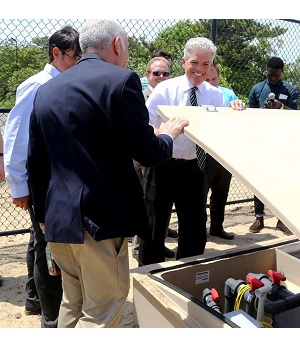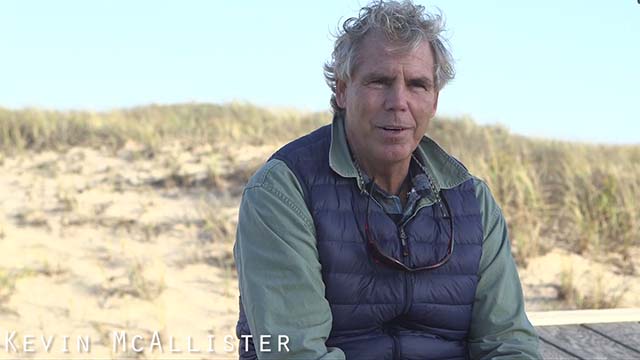In response to the unfortunate and unhealthy issues that have affected the quality of the drinking water here on the East End, including shellfish dying, algae, fish kills, toxins and a myriad of other pollution factors, Suffolk County Executive Steve Bellone recently announced a plan to raise money for water quality efforts by adding a surcharge to water bills for customers of the Suffolk County Water Authority and other water providers.
Those in a position of authority and informed knowledge, including civic leaders, environmentalists, researchers, and county and state policymakers have all acknowledged the problem exists, which is deemed a “crisis” by Bellone.
 |
|
County Executive Bellone and Supervisor Schneiderman at Meschutt Beach County Park on June 1st, installing a new innovative advanced wastewater treatment system which replaced a failing cesspool. (Courtesy Photo) |
The problem has been identified as excessive nitrogen, a result of human waste that seeps into the aquifer, ponds and bays and any surface waters from old residential cesspools or septic systems that do not treat wastewater effectively. This conclusion, in and of itself, is a victory for many who have argued for years over exactly what was causing the problem.
If the proposal meets with approval and is passed by voters in Suffolk County, a surcharge tax of $1 on every 1,000 gallons of water used would be assessed, resulting in an approximate $75 million to be applied to the Suffolk Reclaim Our Water initiative on an annual basis. How would the funds be used? Bellone has indicated that moving away from the use of cesspools and septic systems would be expedited, thus accelerating the use of more advanced treatment systems to remove that nasty nitrogen. These funds “could pay for water quality infrastructure,” according to Bellone.
Bellone further relayed, “An IBM Report identified the cost of addressing our clean water infrastructure needs at $8 billion throughout Suffolk County. It is clear that we need a stable, recurring, dedicated revenue source to invest in clean water infrastructure without putting too heavy a burden on any one individual homeowner.”
When asked if he feels taxpayers have recognized the seriousness of this situation, and are not simply being assessed for a surcharge, Bellone responded, “Suffolk County residents understand our clean water crisis and the importance of implementing solutions. I am very confident that if we give them the opportunity to solve it, they will embrace it.”
Speaking with Kevin McAllister, a baykeeper since 1998, and founder of DefendH2O, formed in 2014, who has been a long-time advocate and proponent of protecting and restoring “the environmental quality of groundwater, surface waters, wetlands and beaches on and around Long Island,” he offered, “This action is absolutely necessary, and I feel very positive about the creation of this fund.”
 |
|
Kevin McAllister, a baykeeper since 1998, and founder of DefendH2O, formed in 2014. (Courtesy Photo) |
McAllister further explained, “We need a big pot of money to ultimately offset the costs for fixing our problems. I feel very strongly that this plan is a work in progress, and that very stringent performance and discharge standards need to be applied to these new systems. If the county fund is going to be applied to advance systems, it will still take decades to transition and offset the present trajectory. Right now there are 300,000 plus homes that have poor cesspool unsafe water quality, and although this is a starting point that I applaud, people want to see results and should use their voice and pay very close attention so this plan can be as strong as possible and generate results with achievable levels.”
Commenting on the next steps, Bellone advised, “Suffolk County will continue to take steps forward to improve water quality, recognizing that maintaining the status quo, where more than 360,000 homes are unsewered and do not have any advanced wastewater treatment system is unacceptable. The only way to reverse the decades of decline that we have seen in our water quality is to invest in clean water infrastructure: upgrade septics and cesspools and expand sewers and improved water quality treatment systems. By providing options for single-home water quality treatment systems to individual homeowners or by sewering, Suffolk County can significantly reduce its nitrogen water pollution. New single-home water quality treatment systems reduce nitrogen pollution by more than 50 percent and sewers reduce nitrogen pollution by more than 90 percent. This year, Suffolk County will be permitting advanced single-home treatment systems for use for the first time.”












